#homodont
Explore tagged Tumblr posts
Photo

#human#dentition#pleurodont#monophyodont#homodont#thecodont#diphyodont#heterodont#theocodont#science#solutions
1 note
·
View note
Text
Cannot decide whether Eldritch Tim should have homodont or heterodont dentition.
Homodont looks more intimidating imo, and the fact that it’s the more primitive dentition for organisms really fits the whole ‘ancestral king-of-all-predators’ thing.


However, heterodont dentition is one of the hallmarks of carnivores (generally excluding fish-eaters). Long canines and shearing carnassial teeth is a key identifying feature of Carnivora.


Given that Tim is monstrous and just… very big in general it wouldn’t really be about the actual function by that point.
#I’m leaning towards homodont since it’s more classically ‘monster-y’ but still.#forgive the stupid post but i like applying the stuff I’m learning in my studies to my AUs and such so bear with me. tying morphology in#- with character/creature design is just a lot of fun#I’ve said it before but the two reasons I even started coming up with the Eldritch AU is because A. Horror AUs are fun and B. it gave me#an excuse to design big spooky monsters.
5 notes
·
View notes
Note
Is it just me or does giant brad have homodont teeth?
(homodont means all your teeth are the exact same shape, brad has teeth shaped similar to a megalodon shark's)
That is correct! He does have!
It's funny because that was exactly my intention but I wasn't aware there was a scientific term for it, thank you for the explanation!
And doesn't his homodont teeth give him the prettiest smile?

176 notes
·
View notes
Text
The NEW Ultrastenos and its Ironic History
So those that have been keeping up with my posts on mekosuchines might recall the name Ultrastenos, as I've talked about this genus back in August of last year. If you've read that post you might also remember how I highlight at multiple points that a lot of the info was tentative on the basis that Ultrastenos was highly incomplete and that close relatives awaited description.
You may also remember "Baru" huberi, a small mekosuchine that lived roughly around the same time, clearly distinct from Baru yet at that point still unnamed. Oh, how I wished for the former to get more material and for the latter to recieve a proper genus assignment.
My now outdated reconstructions for "Baru" huberi (the small one in the left image) and Ultrastenos (right image)

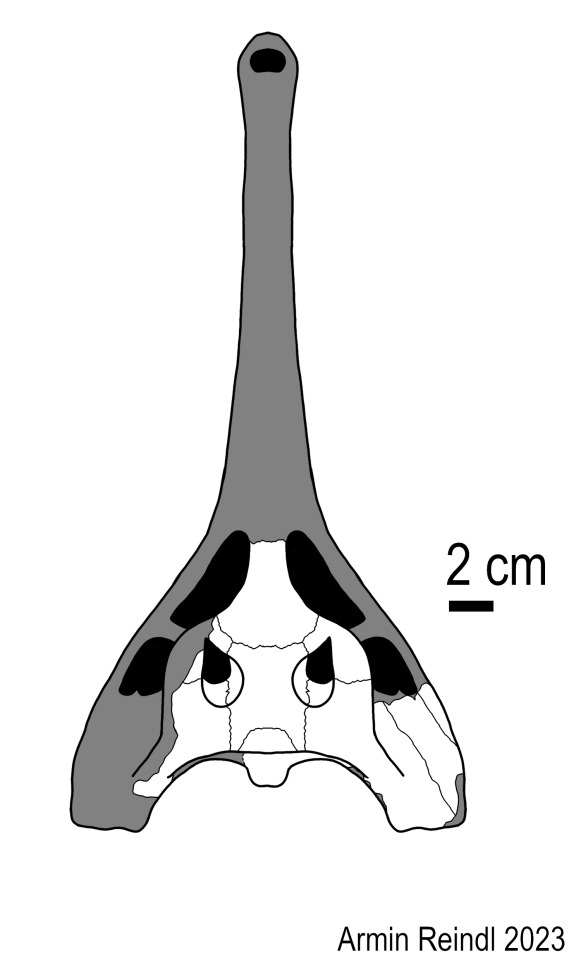
And then the monkey's paw curled.
As it turns out....they are the same damn animal. Now, back when "Baru" huberi was described, Willis also named a bunch of other mekosuchines from the same locality (the White Hunter Site of the Riversleigh WHA) and described even more material that remained unnamed, including the White Hunter Cranial Form 1. Now, when Ultrastenos was named in 2016, the type material was from the Low Lion Site (also Riversleigh), but importantly, the skull tables identified as WHCF1 were also assigned to the genus (and were the basis for my reconstruction).
Well, re-examination has shown that the WHCF1 and the holotype of "Baru" huberi aren't just a single species.....THEY ARE A SINGLE INDIVIDUAL.
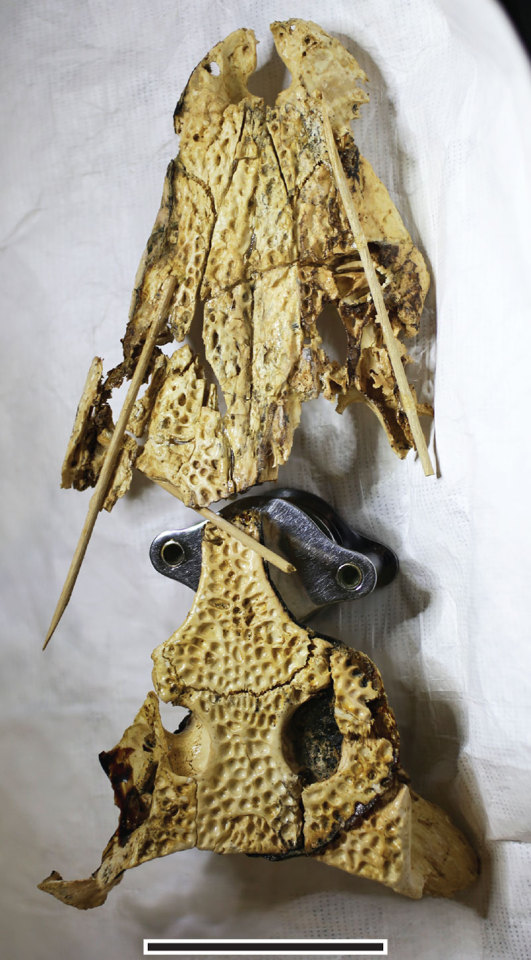
Given the fact that the assignment of the skull table to the Low Lion Ultrastenos material still holds up, this means that Ultrastenos willisi and "Baru" huberi are a single taxon. Which consequently requires some reshuffling of the names.
"Baru" huberi was named first, so the species name takes priority and continues being used. However, since it was never given a genus name, Ultrastenos does stay valid. Except now it's called Ultrastenos huberi, not Ultrastenos willisi. A name that has aged like milk. Back in 2016 it was proposed that Ultrastenos had a very narrow snout (thus the name), so now that we know that the rostrum was flat and mesorostrine, the name really is just wrong.
So next up, lets examine what went wrong.
As I said before, Ultrastenos was fragmentary, so that certainly played a big part in it. But the team in charge of describing the animal still cited several lines of thinking to support their interpretation, most of which are now thoroughly debunked.
As an example, the lower jaw was rather shallow, however while this was initially taken as evidence for longirostry, the 2024 paper states that this only an argument against altirostry (a deep skull), not against a more generalized condition. The teeth were also initially used as evidence, citing their homodont condition (the teeth looked uniform), HOWEVER, the problem in that was that there were only a few teeth present, all of which notably do not bear any resemblance to the needle-like teeth seen in other long-snouted taxa. Another important clue initially taken to mean longirostry was the orientation of the quadrate area and the seemingly sudden constriction of the lower jaw. But the quadrate area was not found in articulation and would support a generalized skull form if simply rotated a little, while the constriction of the mandible appears to at least be partially exaggerated by preservation.
Of course, the fact that we now have proper material of the snout makes the interpretation of a generalized skull shape a lot more solid.
Image 1: The left and right halves of the mandible of Ultrastenos compared to that of Baru iylwenpeny (D), note how the right half is a lot more straight. Image 2: The initial reconstruction of the quadrate area of Ultrastenos compared to one that is slightly rotated Image 3: The revamped skull reconstruction by Yates and Stein
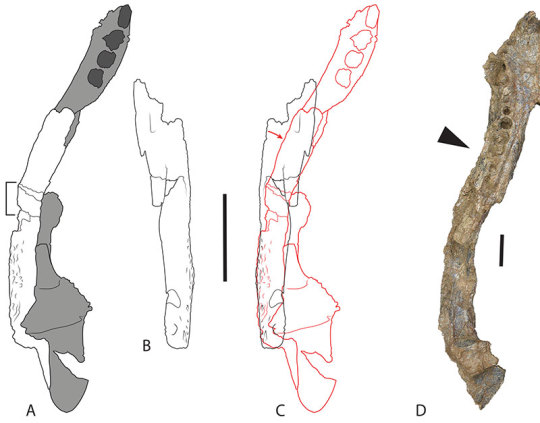
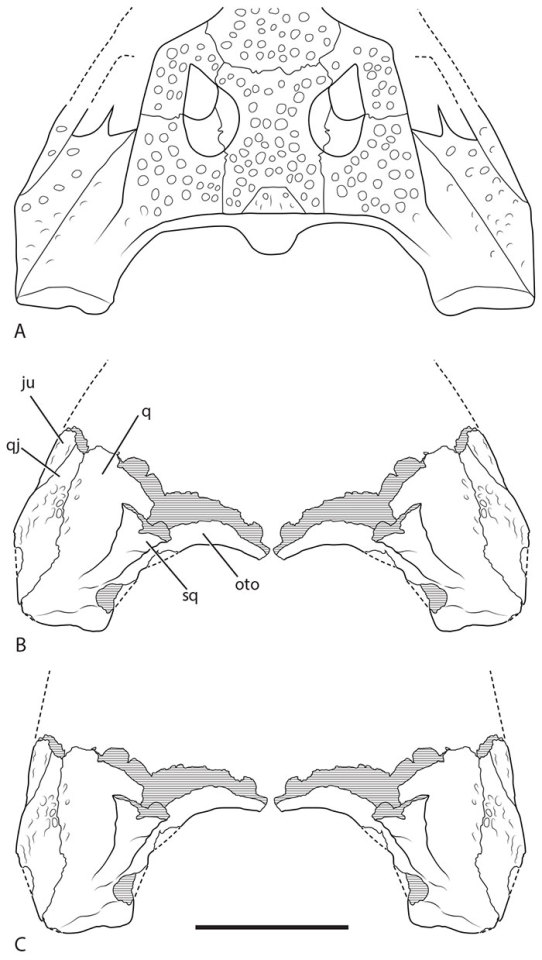
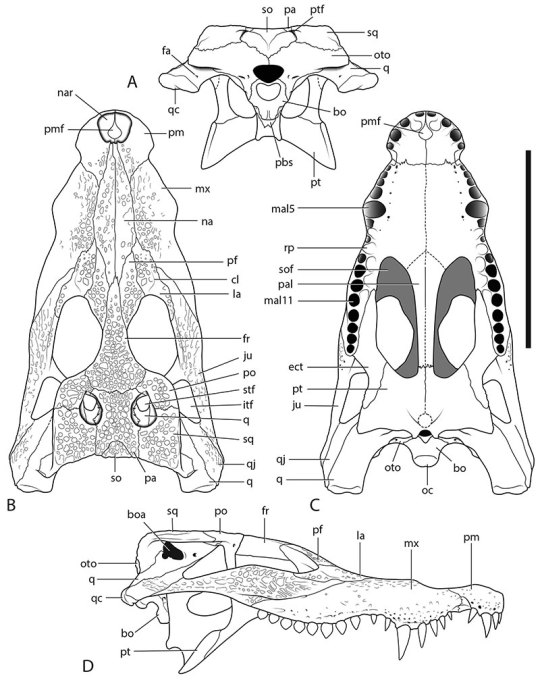
The size of the animal does stay relatively unaffected by these new discoveries. "Baru" huberi has been estimated at only around 1.5 meters in length and my own scaling of Ultrastenos got up to 2 meters, which seems to be in line with what is still assumed for this animal. So among aquatic mekosuchines, its still rather small.
There are however some interesting implications for mekosuchines at large. Now that we no longer have a longirostrine member of this family, one has to wonder, why is that? Well, there might be several reasons.
It could be that the types of environments that were present in Cenozoic Australia simply didn't support such animals. Even in the type description, its been noted that the Riversleigh isn't exactly known for its fish remains, leading to the idea that Ultrastenos might have gone for other small vertebrates like frogs. Hell, the ecology of Baru might suggest that the reason that this genus was so robust might tie to the fact that the local bodies of water just weren't deep enough to allow the typical crocodilian grab-and-drown tactic.
Competition might have been another factor. In environments that may have been more suitable for such morphology, mekosuchines might have been beaten to the punch by other types of crocodilians. Harpacochampsa for example, tho originally thought to be a mekosuchine, is now more often regarded as either an unrelated crocodile or a gharial and its very possible that it filling the nische of a longirostrine simply meant that mekosuchines didn't have the opportunity to expand into that space. Same goes for Gunggamarandu in the Pliocene and Pleistocene and Freshwater Crocodiles from the Pleistocene onwards. (Tho it should be noted that both Harpacochampsa and Gunggamarandu are so fragmentary that their snout shape is technically unknown).
Images: Gunggamarandu (Eleanor Pease), Harpacochampsa (ArtbyJRC) and Freshies (Antoni Camozzato) might have been key factors in why mekosuchines never evolved slender snouts.
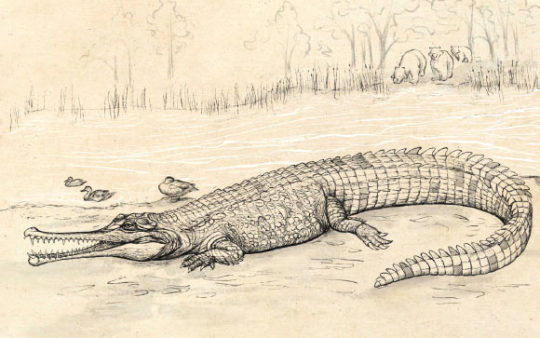
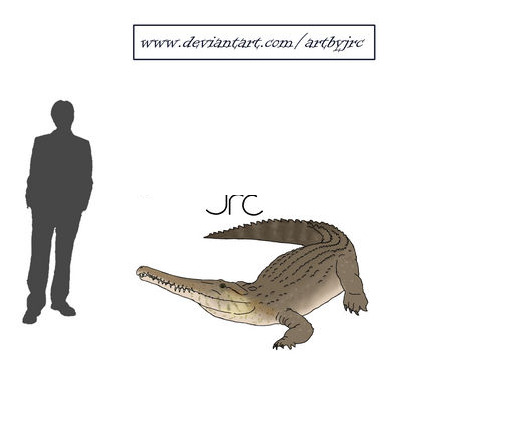
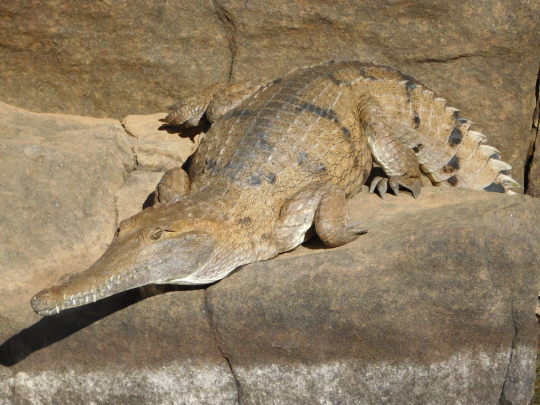
Finally, its also possible that something in the growth of mekosuchines simply prevents them from evolving longirostrine skulls, which Yates and Stein liken to alligatoroids (notably the closest alligatoroids got to traditional longirostry as seen in gharials is the Rio Apaporis Caiman, and even that one is closer to some extant crocodiles in its morphology).
Whatever the case, I for one mourn the loss of our long-snouted Ultrastenos. Tho as a note for any paleoartists, there is not a single illustration of this new interpretation since nobody ever drew "Baru" huberi either. Wink wink nudge nudge
Links:
https://en.wikipedia.org/wiki/Ultrasteno
Ultrastenos revised (palaeo-electronica.org)
#long post#harpacochampsa#ultrastenos#baru huberi#mekosuchinae#gunggamarandu#oligocene#riversleigh#paleontology#palaeoblr#croc#crocodile#crocodilia#prehistory#cenozoic
53 notes
·
View notes
Text

i’m either way too high and smug or just now realizing i may be good with words
18 notes
·
View notes
Text
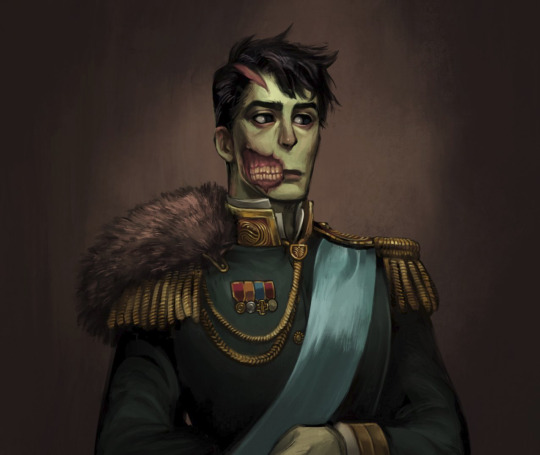
i’m so bothered by how brian doesn’t have human dentition here. like.
this mans doesnt have canine teeth. hell, he doesn’t have any differentiated teeth at all, he’s a homodont. is brian even a mammal? are zombies not mammalian in the lore of monster prom?
he has way too many teeth too and they go too far back. what the fuck.
#all the care guide says is 'biomass'#monster prom#Monster Roadtrip#me shaking brian and asking him if he's a sauropsid or a synapsid
131 notes
·
View notes
Text
me researching ways to make the mers ~weird~
i kinda wanna indicate the last common ancestor of them and humans was... a long-ass fucking time ago. similarities come from convergent evolution, maybe specifically predation
-might have a parietal eye
-might have gular/thoracic and post/paracloacal scent gland(s)... cloacal glands used in marking territory
-fish nostrils = nares
-nose==snout
-two dorsal fins with separate bases
-lateral line organ
- 5 year gestation?
- 7 fins – two dorsal fins, two pectoral fins, two pelvic fins and one caudal fin
- spiracle-ear?
- operculum? (gill cover bone that helps draw in water)
- ears: basilar papilla?
- gills+spiracles need to remain moist
- cosmoid/(elasmoid)/ganoid scales
- good sense of smell
- lackluster amphibian eyesight
- metamorphosis
- sequential hermaphrodites?
- palatal teeth~~~
- anamniotes
- fewer ear bones than humans/synapsids, columella or maybe a stapes? more jaw bones
- maybe should have an ear drum in the otic notch? -> no spiracle (bird/crocodile ears) or could breathe air thru the spiracle
- Both sexes have a cloaca, a single chamber and outlet at the base of the tail into which the intestinal, urinary and genital tracts open.[32] It houses the penis in males and the clitoris in females.[36] The crocodilian penis is permanently erect and relies on cloacal muscles for eversion and elastic ligaments and a tendon for recoil.
- teeth visible when mouth closed like crocodilians?
- scleral cartilage
- nictating membranes!
The head or skull includes the skull roof (a set of bones covering the brain, eyes and nostrils), the snout (from the eye to the forward-most point of the upper jaw), the operculum or gill cover (absent in sharks and jawless fish), and the cheek, which extends from the eye to the preopercle. The operculum and preopercle may or may not have spines. In sharks and some primitive bony fish the spiracle, a small extra gill opening, is found behind each eye.
Juvenile P. mokelembembe have external gills that resemble those of young amphibians. These gills are large and have branching, featherlike architecture to maximize surface area for oxygen exchange to compensate for the young fish's underdeveloped respiratory system. As the fish age and their lungs develop, they lose these external gill structures and take on the gill structure of a typical fish.
primitive shape of its jawbones are more akin to that of a salamander's than a fish.[7]
The mouth is large and appears to grin when closed. The dentary, premaxilla, and maxilla each carry one row of large, slightly recurved teeth.[4] There are multiple rows of smaller teeth, found between the rows of large teeth, on the prearticular and coronoids in the lower jaw and on the bones forming the roof of the mouth.
Being shallow-water fishes, the elpistostegalians evolved many of the basic adaptions that later allowed the tetrapods to become terrestrial animals. The most important ones were the shift of main propulsion apparatus from the tail fin to the pectoral and pelvic fins, and a shift to reliance on lungs rather than gills as the main means of obtaining oxygen.[12] Both of these appear to be a direct result of moving to an inland freshwater mode of living.[13]
Crocodilians are homodonts, meaning each of their teeth are all of the same type (they do not possess different tooth types, such as canines and molars) and polyphyodonts are able to replace each of their approximately 80 teeth up to 50 times in their 35 to 75-year lifespan.[51] They are the only non-mammalian vertebrates with tooth sockets.[52] Next to each full-grown tooth there is a small replacement tooth and an odontogenic stem cell in the dental lamina in standby, which can be activated when required.[53] Tooth replacement slows significantly and eventually stops as the animal grows old.[
It has a cleithrum, a bone in the pectoral girdle that extends from the scapula. The cleithrum once attached to the skull in lobe-finned fish, the ancestors of tetrapods, but detached to allow the neck to move freely.
2 notes
·
View notes
Text
Toffee is canonically a homodont. This man does not have differentiated teeth.
2 notes
·
View notes
Text
I believe the majority of vertebrates are capable of repeated tooth replacement. It's particularly notable in some like sharks and crocs, but I think most reptiles, amphibians and fish can do it. Dinosaurs with teeth could keep replacing them (some just had beaks, and not just birds).
Mammals are the weird ones that typically only get two sets, and that seems to have come along with our incredibly complex, specialized and heterodont teeth (heterodont meaning incisors, canines, molars etc. Most tetrapods are homodont, with all teeth being pretty similar throughout the mouth)

91K notes
·
View notes
Text
Mod 4 General Topics
Subclass Prototheria
Primitive, oviparous mammals.
Has a single order, Monotremata.
Confined to the Australia region.
Ex: Platypus and Spiny Anteater.
Has reptilian, avian, and mammalian affinities along with some other peculiar characters.
Reptilian affinities: Presence of Cloaca, Body temp. not constant, can withstand starvation for a long period, and eggs are large with a leathery shell
Avian affinities: Shape of platypus beak resembles a duck bill, teeth are absent and feet are webbed.
Mammalian affinities: Body covered in hair, skin richly glandular, a typical mammalian diaphragm divided the body cavity, heart 4-chambered, and presence of milk glands secreting milk.
Peculiar characters: Presence of tarsal spurs in male, milk glands derived from sweat glands and without teats, temporary abdominal marsupial pouch in female during breeding season, and the right ovary is smaller and usually functionless.
Dentition in Mammals
Arrangement of teeth in vertebrae is termed dentition, teeth are most specialized in mammals.
Teeth play an important role in everyday life of animals. They
1. Grasp and hold prey or food in the mouth cavity
2. Serve as a grinding mill for chewing food.
3. Serve as weapons for offence or defense to tear organs.
I. Shape of Teeth: teeth can be differentiated into homodont or heterodont.
Homodont teeth are all similar in shape and size, common in vertebrate other than mammals.
Heterodont teeth are dissimilar in shape and size. They are distinguished into several types such as incisors, canines, premolars, and molars. The differentiation depends on the nature of food eaten and the manner of securing it.
II. Attachment of Teeth: The manner of attachment of teeth at the bases with the jaw bones varies.
Acrodont: Teeth are attached to the free surface or summit of the jaw bone. Can break easily but also are replaced. Ex: shark
Pleurodont: Teeth are attached to the inner side of jaw bone by their base and well as one side. Ex: lizard
Both of the above are rootless, nerves and blood vessels enter the pulp cavity along the lateral side.
Thecodont: Teeth have well developed roots implanted in deep individual pits called theca in the jaw bone. Ex: mammals
III. Succession of Teeth: According to their permanence or succession:
Polyphyodont: Teeth can be replaced an indefinite number of times during their life. Ex: Lower vertebrates
Diphyodont: Teeth develop in two successive sets, common in mammals.
The first set are called milk teeth, they erupt after birth in most but in bats they form and shed before birth. Milk dentition has no molars.
Milk teeth are later replaced with permanent teeth which last throughout life. Can't be replaced if lost. Anteaters have more milk teeth than perm.
Monophyodont: Only one set of teeth develops, found in some mammals like platypus.
IV. Kinds of Teeth: 4 types, incisors, canines, premolar, molars.
Incisors: The front teeth which are borne by the premaxillae in upper jaw and tips of dentaries in lower jaw. They are single-rooted, monocuspid and long, curved and sharp-edged. They are adapted for seizing, cutting and biting
Canines: A single canine tooth occurs in each half of each jaw, just outside the incisors. Upper canines are the first teeth on maxillae. Canines are generally elongated, single rooted and with a conical sharp monocuspid crown. They are meant for piercing, tearing, offence, and defence.
Cheek Teeth: includes both premolars and molars. Their crowns have broad surfaces with ridges and tubercles meant for crushing, grinding and chewing.
Premolars: usually have two roots and two cusps and are represented in milk dentition.
Molars: generally have more than two roots and several cusps, do not have milk predecessors.
V. Dental Formula:
The number of teeth varies in different
species. However, enough teeth are constant and characteristic for every species of mammals. Therefore the number of teeth in a species can be represented by an equation called the dental formula.
Since two halves of each jaw are identical, only the teeth of one side are recorded. Those of the upper and lower jaws are separated by a horizontal line. Kinds of teeth are denoted by their initial letters: i, c, pm and m. Number of teeth shown in the formula multiplied by 2 gives the total number of teeth in a species.
Examples below
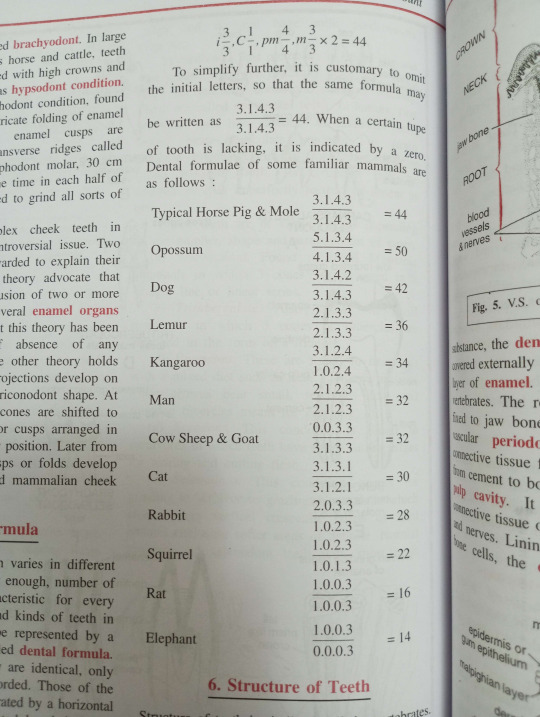
VI. Structure of Teeth
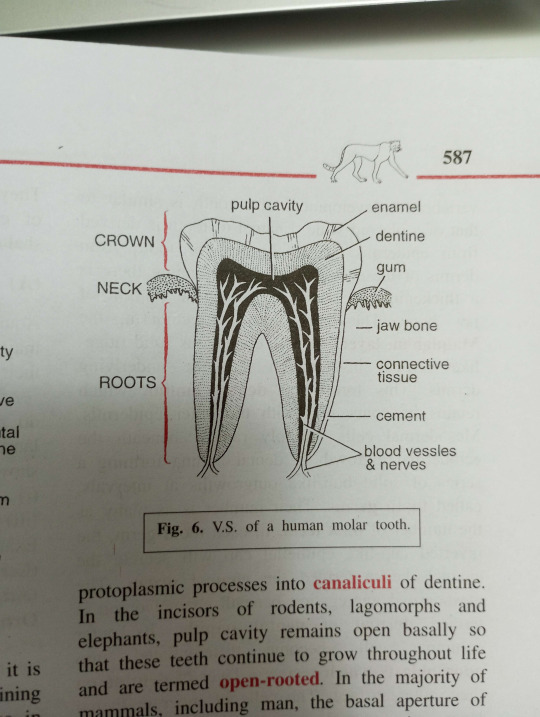
Aquatic Adaptations in Mammals
Mammals are primarily terrestrial animals, but some of them have secondarily adopted an aquatic mode of life. All of them still breath air though lungs.
Some have reverted to water because of extreme competition for food and shelter on land.
Aquatic adaptations fall into 3 main categories: modification of original structure, loss of structure, and development of new structure.
Modification of Original Structure:
1. Body Shape: Their external bodies have adapted into a fish like form with an elongated head, indistinct neck, and a tapering streamlined body which offers little resistance and swims rapidly.
2. Large size and weight: The larger size reduces skin friction and heat loss, but creates no problem for support in water due to buoyancy.
3. Flippers: Forelimbs are transformed into skin-covered unjointed flippers which have no separate fingers, they can move as a whole at the shoulder joint. Flippers serve as balancer and provide stability.
4. Hyperdactyly: Extra digits, up to 14 or more, serve to enlarge the surface area of the flipper for greater utility when swimming.
5. High and Valvular nostrils: Nostrils are placed far back on the top of the head so the animal can breath hair without having to raise it's head out of water too much. They can also be closed by valves as they dive.
6. Mammary ducts: During lactation, ducts of mammary glands dilate to form large reservoirs of milk which are pumped directly into the mouth of young by the action of a special compressor muscle. This allows suckling of young underwater.
7. Oblique diaphragm: An oblique diaphragm makes the thoracic cavity larger, dorsal, and barrel shaped, providing more space for lungs to expand.
8. Large lungs: Large and highly elastic lungs ensure taking in the maximum amount of air in before diving down. Like swim bladders in fish, the dorsal lungs also serve to maintaining a horizontal posture while swimming.
Loss of Structures:
Most hair is lost with the exception of some sensory hairs on snout or lips. Pinnae absent too. Both may obstruct the even flow of water over body surface and interfere with the speed and elegance of movement through water.
Eye cleansing nictitating membranes, lacrimal glands, and every other kinda of skin glands are absent because they are useless under water.
Skin loses its muscles and nerves due to thickening and immobility.
Hindlimbs are only represented in fetus as little nobs, disappear in adults.
Pelvis is rudimentary.
Fingernails are absent but present as traces in fetus.
Scrotal sacs are absent as testes remain inside the abdomen.
Development of New Structures:
1. Tail flukes: the tail develops large, lateral or horizontal expansions of skin called flukes. They are not supported by fin rays. Their up and down stroke both propel the body in water and help in rapid return to the surface.
2. Dorsal fin: An unpaired adipose dorsal fin without skeletal support, serves as a rudder or keel.
3. Blubber: The thick subcutaneous layer of fat. It compensates for the lack of hair by acting as a heat insulator. It also provides a ready reservoir of food and water during emergency. The fat also reduces the gravity of the animal and imparts buoyancy.
4. Harderian glands: Eyes under water remain protected by a special fatty secretion of harderian glands.
Flying Adaptations in Mammals
Flight can be seen in two ways in mammals: gliding and flapping.
Gliding is seen in flying lemurs and squirrels while flapping is seen in bats.
Gliding Adaptations:
The body is elongated, flattened and streamlined. The limbs are long and equal, tail is long and gradually tapering.
There is a double fold of furred skin called patagium or parachute membrane, stretched on either lateral side between neck, limbs, body, and tail.
Sometimes it it reinforced with a cartilaginous rod springing from the elbow or wrist.
Flapping Adaptations:
Bats are the only mammals with true and sustained flight effected by the flapping of wings. To adapt, radical changes have taken place internally in their skeleton and musculature. Their skill has been adjusted in an exaggerated manor too.
1. Wings: Wings or patagia are paper thin, elastic membranes which are extensions of leathery skin from the lateral sides of body, legs, and tail. The forearm is greatly elongated, carrying a hand with 5 very long fingers.
The first finger, the pollex, is short, free, and sharply clawed. The other 4 fingers are clawless (sometimes the 2nd is clawed), enormously lengthened and embedded in the wing web to support it. The fingers act like the ribs of an umbrella which opens and closes the wing and keeps it taut when expanded.
In most bats, an inter-femoral membrane also encloses the tail, it extends between the hindlimbs. A spur of bone, the calcar, projects from the tarsus of each foot. And a similar ante-brachial membrane connects the neck with the humerus bone of upper art. With these, there is a continuous and uninterrupted parachute of skin around the bat's body.
2. Legs: The hindlegs are small, weak, and have sharp tow claws used for suspending the bat upside down from a branch or perch while resting. Knee joints are pointed backwards instead of forwards, it helps in maximum spread of wing membrane.
3. Tail: Tail is variable in size. When well developed, the tail supports the inter-femoral membrane and acts as a break when flying. It also is used as a pouch for holding food or prey. May even be used as an aerial cradle for a new born bat.
4. Teeth: Milk dentition, Young are often born with small hook-like or needle-like teeth, they are supposed to serve the young for gripping firmly to the maternal teats while she is flying.
5. Senses: bats are extremely modified for nocturnal flight. They can fly in the dark and avoid obstacles with echolocation, their ears are supersensitive.
0 notes
Text
when stu-dying Bio
so i have a bio exam in approximately 5 hours and i just read these two beautiful words ‘heterodont’ and ‘homodont’ and now i can’t stop laughing.
3 notes
·
View notes
Text
Bestiary
A guide to mythical beasts- within my works, anyways.
(These are not hard and fast rules even within my fics/universes/AUs, but they are general guidelines I try to keep close to- a lot of this is inspired by my studies in wildlife, so some features/behaviors may diverge slightly from the standard concept)
Siren:
Physical-
Sirens appear as half-humanoid, half-aquatic creatures- their upper body is somewhat human, with everything from the hips-down instead resembling the body of a fish (or in some cases a serpent).
Their appearance varies dramatically- they come in all sorts of patterns, scale types, shapes, etc. Generally, their bodies are longer than a fish of equal size would be, with older individuals being long enough to be suitably called ‘sea serpents’. All sirens usually possess darkened forearms, scales scattered across their backs/shoulders/faces, webbed + taloned fingers, and dark sclera to help them see underwater. 4-6 gills found between ribs- possess lungs for breathing air.
Pupils are thin and cat-like- they possess ‘third eyelids’ to help shield their eyes when swimming.
Sirens’ bodies are covered in bioluminescent patterning that appears at will- this is used in communication, and to find members of their group in deep water.
Teeth are homodont- broad, even, and meant to crush bone. Dentition is deciduous.
Extremely strong: their bodies are built to cling to rocks and battle the surf as they swim near the cliffs and reefs they call home.
Always cool to the touch- scales are sturdy, resembling those of fish like gar.
Behavioral-
Hypercarnivores- consume mostly fish + shellfish, as well as the occasional seabird. One of the few mythical creatures known to actively hunt humans- often develop a ‘taste’ for red meat.
Hunting strategy depends on target- aquatic prey is pursued until it is too exhausted to flee further, or overtaken by a burst of speed. Terrestrial prey is grabbed and pulled underwater to drown (sometimes aided by their ‘song’, if the prey is human).
Complex social structure. Live in large groups known as ‘pods’, often consisting of one or two family units (though this is not always the case)- extremely territorial and will fight other sirens or similar creatures to maintain control of their territory. Maintain a hierarchy within the group led by the dominant pair (known as the ‘matriarch’/‘patriarch’).
Capable of human speech, possess the gift of tongues- communicates with own kind through whistles, clicks, growls or hisses (purrs when content). Glowing patterns are used for complex underwater language, consisting of different flash patterns and hand signals. These underwater signs are region-specific.
Sirens, like any humanoid creature, can be any combination of personalities and natures- culturally, they are a cunning, brutal species that values strength and guile. They are known to be exceptionally curious, and almost cat-like in playfulness, but this also makes them very dangerous. Many a human has met their watery grave simply due to a siren’s curiosity leading them to pull the object of their interest into the water, only to abandon them when they grow bored/accidentally maul their plaything.
Ecology-
Can be found in freshwater, but largely marine. Range occasionally extends far from shore (dozens of miles, if the pod is large enough), but they rarely stray into empty open water- sirens require rocks or seabeds to roost. Pods live in shared dens, usually formed in reefs or sea caves- these are decorated with scraps stolen from shipwrecks, anything shiny or eye-catching, and bits of bones from their kills.
Crepuscular, though it’s not uncommon to see them perched on rocks, basking, in the day time.
Behaviorally ectothermic (basking), but partially warm-blooded. Can be found very far north.
Aquatic, but capable of moving about on land for brief periods of time (even occasionally roosting out-of-water when warm enough). Use arms to drag body along. Can breath air indefinitely, but prolonged lack of water dries out their scales + gills and will kill them.
By the time they reach adult size, they have few natural predators- orca will hunt them in northern regions/along migration routes, and opportunistic giant squid can occasionally overpower them.
Often hunted as a nuisance (due to fears of predation), for their scales, or, in some regions, as a delicacy. Have become quite rare as a result.
Magical Ability-
Sirens, being members of the Fae order, possess magic- most famously, the ‘siren song’. While not actually a song in the traditional sense, the siren’s song is a low, humming sound with a mesmerizing, hypnotic effect. Depending on the pitch and volume, a siren can disorient someone, freeze them in place, or even lull them to sleep. Sirens who prey on humans often use their songs to do so, though it is also used defensively, enabling a siren to flee when cornered.
Vampire:
Physical-
Appear mostly humanoid, save for long pointed ears, slit pupils, sharply clawed hands, and large, bat-like wings (typically held with clawed joint hanging onto shoulder, allowing wings to fall across back like a cloak).
Signature heterodont teeth- all teeth slightly pointed, back molar forms carnassial tooth. Canine teeth are long, deeply-rooted and sturdy- contrary to popular believe, these are not for ‘sucking blood’, but instead serve as holding/slashing implements.
Eyes are adapted to see well in the darkness- sharp hearing and very sharp sense of smell.
Adults are significantly stronger than an average human.
Otherwise, appear very much like humankind.
Behavioral-
Carnivorous- diet consists of almost entirely small mammals, consuming some flesh (though mostly blood).
Quick, easily startled, and smaller than other mythical creatures (they are human-sized)- more prone to flee than fight, when alarmed.
Form tight-knit family units, and are usually quite dedicated parents.
Avoid daylight hours- skin burns very easily, and sensitive nighttime vision leaves them half-blinded in the light of the sun.
Not territorial, but will attack other vampires in squabbles between families. These battles rarely end in death, but can result in severe mauling of the losing party as others join in to drive them away.
Purr when content.
As in appearance, vampires otherwise resemble humans closely in behavior, living in old homes and going about disguised as such during the evenings when they must. They have adapted to a human world by hiding themselves within it. Many use this disguise to lure humans in, only to attack them and drain them of blood- such attacks are rarely fatal, but blood loss is severe and the bites, improperly managed, can be quite painful.
Ecology-
Small, nocturnal, specialized predators for feeding on blood and then fleeing the scene.
Can terrorize humans easily, but in comparison to other mythological humanoids, they are physically weaker.
Primarily found near human settlements, taking up roosts in older buildings and estates. They have a love for finery and beautiful things (they are almost always expertly dressed).
Often persecuted by humankind, believed to be demonic in nature- vampires are incredibly susceptible to fire and are often burned out of their homes, only to be captured and killed. Many powerful families have grudges against humankind as a result.
Natural rivalry with werewolves.
Magical Ability-
Skilled use of Mesmer to disorient/control targets and keep them from struggling when being bitten. Mild venom in bite that also helps with struggling prey.
Can ‘turn’ a human into a vampire through a specialized bite + a little bit of magic. The scars of said bite never heal, though the turned vampire is, by all accounts, physically the same as one who was born a vampire. Culturally among vampires, this is only done to humans one is very fond of, as one’s turned ‘thrall’ is considered their responsibility to care for. It’s a matter taken quite seriously.
Many possess the ability to turn into a bat- either for ease of travel, easier roosting, or simply because they think it’s neat.
Gorgon:
Physical-
Similar to sirens, the upper body is humanoid, with their lower half taking the form of that of a massive serpent. Appearances vary- some are stocky, others thin, some have keeled scales, others smooth. It is as variable as serpents themselves.
General features include: scaled stomachs + scattered scales across back and shoulders, scaled arms + fingers, sharp, sturdy claws, and slit pupils. Tongues are extremely long, dark and forked. Some have rows of short spikes, such as along their shoulders or spine.
Teeth are largely homodont and deeply rooted- rather than possessing traditional hypodermic fangs, a gorgon’s ‘canine’ teeth are grooved in order to flood their prey’s wounds with venom.
Venom is typically neurotoxic, resulting in labored breathing, tremors, rapid heart rate/weak pulse, and sudden weakness. Some hemotoxic individuals exist, with symptoms being severe pain, heavy bruising around bite site, disorientation, and eventual sloughing of flesh from the wound.
Serpentine bodies are heavily muscled and incredibly strong.
Jacobson’s organ on roof of mouth enables them to ‘taste’ the air- exceptionally keen sense of smell.
Near-silent in motion and leave few tracks behind.
Can grow to be quite large- more than 4 meters tall, with their bodies reaching up to 14 meters long. Average around 2.5 meters tall and 10 meters long.
Behavioral-
Hypercarnivores. Diet consists of any prey they can kill- ungulates such as deer and cattle are common, though anything is fair game. Some larger individuals have been recorded preying on smaller dragon species. Similar to sirens, gorgons have been found to hunt humans in times where other food is scarce, or when their territories overlap with human settlements, leading to conflict.
Hunting strategy usually depends on the size of the gorgon in question- smaller individuals favor a bite-and-release approach, only pursuing prey to kill when it has been weakened by venom. Larger individuals instead coil around their prey, biting repeatedly with the intent of causing severe blood loss + shock. Some forgo that entirely and instead crush their prey to death.
Largely solitary and extremely territorial. Maintain a large hunting ground scattered with several smaller nests + one main den. Those who intrude upon their hunting grounds find themselves the target of a vicious attack, sometimes ending in the loser as prey- even if they’re other gorgons.
Exhibit hoarding behavior similar to dragons, stashing away any gold or valuables stolen or unearthed in their main den. Unlike dragons, they won’t go out of their way to collect a hoard, but they will defend it ferociously.
While active when actually on the hunt/patrolling their territory, gorgons are rather lazy creatures, and spend most of their time sleeping.
Sometimes form small family units while raising young or among hatchmates, but most abandon their offspring early to fend for themselves.
Gorgons are fierce, brutal creatures, prone to grudges- they are known to play games with victims, taunting and tormenting them if their ire has been earned. However, if somehow befriended, they are excellent protectors. While not particularly curious, they are easily distracted and easily amused- they are also easy to flatter.
Ecology-
By the time they are fully grown, they are usually the dominant predator in their local ecosystem, keeping other large creatures in check.
Rare- fatal territorial disputes, a low rate of individuals making it to adulthood, and human/gorgon conflict leave their numbers rather low. Can be found in most temperate-to-tropical/grassland environments as long as there is sufficient food and, more importantly, sufficient warmth.
Enjoy swimming (especially while in shed) and often make their homes near water. Can hold their breath from 30 mins to an hour.
Ectothermic, require environmental heat to regulate body temperature. Can sometimes be partially endothermic if food supply is plentiful, but during the colder months they largely just hibernate.
Nocturnal, diurnal or crepuscular, depending on individual’s preference.
Frequently hunted by humans (and other mythical humanoids) for fear of predation and for their skins. While fearsome, gorgons can be overpowered by sheer numbers, and the use of snares has proven to catch them (as they move quite low to the ground). Gorgons are often blamed for loss of livestock, though this seems to be uncommon and more likely the result of local dragon activity.
Magical Ability-
Most gorgons lack traditional magic (they are not members of the Fae order), but they do have a form of the Mesmer in the form of an intense, paralyzing stare.
Some have been recorded as possessing the ability to turn those they look upon into stone, though (understandably) this has yet to be confirmed safely.
Fae:
Physical-
Tall, humanoid build (6-8 ft), with an almost insectile appearance to them. Ears are long and pointed. Faces are slim, and features are long- limbs are long and jointed like an insects, occasionally spiked along outer edge in mantid-like fashion. Digits are long and sharply clawed for climbing. Two antennae on head (sometimes ‘feathered’ in appearance). Eyes are dark and glittering.
By far their most recognizable feature is their wings- insect-like in appearance (primarily akin to moths or butterflies), they are structured in a fashion similar to a bat’s wing, consisting of a membrane supported by thin supports. Wings are almost always brightly colored- the brighter the wing, the healthier the fae. They use these wings for display, flights between trees, and warmth when sleeping.
Some have bodies armored by chitin in the form of plates, along limbs, chest or throat. Occasionally, they have a ‘ruffed’ neck and shoulders (very soft).
Teeth similar to a human’s, with slightly sharper canine and cheek teeth. Long tongue.
Typically elegantly dressed in lighter furs and leather- decorate themselves with expertly-crafted jewelry and circlets. They are exceptionally showy creatures.
Often decorate themselves with flowers.
Scatter ‘dust’ (wing scales) when they move, as well as pollen that has clung to them as they stalk through their home.
Behavioral-
Omnivorous- diet primarily consists of fruits and flowers, as well as anything sweet they can get their hands on. Only occasionally do they make the effort to hunt down prey (usually small animals such as rabbits, rarely a deer or two).
Extremely complex social structure. Typically two forms of social units- ‘clans’ and ‘courts’. Clans consist of a family unit (often including extended family), while courts are a group of unrelated fae led by one central ruler (similar to a king and his court). These groups can contain up to 20 or so individuals, with the dominant fae being known as the ‘monarch’. The monarch has the absolute final word within their grove.
Each fae or fae group constructs an elaborate grove at the center of their territory, guarded by powerful magic that warps the woods to suit them. Through the power of said magic, the trees within the grove grow unnaturally large and thickly-foliaged, perfect for perching in and sunning. The ground is covered in thick moss and soft grass full of flowers, and a thick thicket rings the grove for protection. Here, each fae constructs their nests and dens to suit them- a fae’s grove is unique to each individual or group.
Fae society is centered around showiness- they gather in large groups to party and make merry (and show off their groves to others). Those looking for partners treat their territories as a bowerbird treats its nest, hoping to attract others’ interest. They are fond of intoxication and get drunk often.
Enjoy singing, typically have very melodic voices.
Largely arboreal, spend much of their time up in the trees, clinging to branch or trunk.
Very protective of their territory and grove, and take meticulous care of the flora within. Despite this, they are not particularly territorial and rarely inclined to disturb each other, unless they have a personal dispute (which is often- they can be exceptionally petty creatures).
Generally very merry creatures, but prone to play tricks and games on other species, at times quite cruelly. They are poor liars but have exceptionally silvered tongues, with strange rules of magic that bind them (never ‘give’ them your name).
Ecology-
Very important ‘ecosystem engineers’ and indicator species- they take exceptional care of the environment within their specific grounds. Plants flourish around them, and wildlife gravitate to these undisturbed patches of wild land. If the forest is unhealthy, the fae will flee it if the damage is too strong to fix, and set up shop elsewhere.
Found in temperate forests and any sort of ‘wild’ lands.
Due to the magic within their grounds, uninvited, human intruders (or other humanoid creatures) will get lost within, stumbling in circles. Kinder fae will guide them out with a firm warning to stay away from their homes- most, however, will simply let the intruder perish among the trees, watching from afar, at times leading victims further in with distant voices and lights (‘will-o-the-wisps’). ‘Feeding the plants’, as they say. The flora within can be quite dangerous in its own right, protecting the grove with oftentimes lethal results- those that make it past such defenses often perish from simple exhaustion, the magic seeping the life from them.
Because of this, while fae are not a species known to hunt humans, they can still be very dangerous- humans they happen to take an interest in can quickly find themselves led astray and trapped by bonds of magic stronger than they can break, to be a sort of ‘pet’ or servant for the monarch.
In kind, however, humans often kill fae they manage to get their hands on, taking their wings as trophies, or using them for their magic. Being both highly social and requiring access to nature, this captivity often kills them in slow, painful fashion. Thus, most fae avoid humankind wherever possible.
Magical Ability-
The strongest magic of all magical creatures. Extremely powerful.
Able to manipulate plants and grow them at will, including those not seen in the natural world alone (massive thorned vines, strange soporific flowers- a favorite trick of theirs-, massive, twisted trees and roots that grab enemies and pull them belowground). Natural life thrives under their care.
Gift of tongues, including many animal species.
Presence can be best described as ‘intoxicating’ to non-fae humanoids- their magic can swiftly lull someone into a state of delirium, disorientation, or deep sleep. Sometimes, this effect is unintentional- other times, they use it to play cruel games, puppeting victims about or making them dance till death by exhaustion. If one has the fortune to have a fae as a friend, however, the effect can soothe pains and help with sleeplessness.
Healing factor, as well as able to heal some wounds in others.
Wide variety of magical skillsets available to them, depending on individual study.
#i was going to add werewolves but this is getting long enough so… here.#feel free to ask questions or offer hcs or whatever- these are just some fun little guidelines I typically follow when making my works!#bestiary#<- I’m gonna start using that tag for this kind of stuff cause it’s neat and I’ll probably do more
4 notes
·
View notes
Text
all of this aside
konrad could easily be the BEST primarch at catching fish w that lovely lack of incisors and he could go hang out with the crocodiles and odontocetes if he truly has nothing but true canines in that mouth of his
however, there is also the question of serration, as seen in many carnivores w homodont or monophyodont dentition, which, while less specialized than (most) mammalian incisors, do allow for slicing through flesh to create smaller chunks before consumption
think big theropod dinosaurs (tyrannosauroidea, allosauria) and how they had to slice off chunks of very large prey (some even doing it in 'hit and run' attacks on ENORMOUS sauropods!) efficiently. So, they evolved serrations along the back edges of their teeth to act as knives. It's likely that konrad may have these too, just so he can really eat at all
most animals w these serrated homodont teeth are not mammals, but the primarchs are goofy warp critters, idk if they have to follow too many biological rules, esp bc there's only so many ways to describe someone having a mouth full of sharp teeth and idk if any BL author wants to get into the minutiae of checks notes tooth form and function. there are dissertations on this shit, there are 12 page papers with and additional replies that add on 20 pages. i would not fault adb or dabnett for not giving too much of a damn and just saying canines 😅
I headcanon that Konrad has PROBABLY tried to eat another human being before. things got rough out there, and his teeth aren’t insanely sharp for no reason.
What’s funny is that BECAUSE of his sharp teeth, it’s actually probably harder for him to eat human beings or any sort of animal for that matter because a mouth of straight canines and nothing else is very bad for chewing, assuming he doesn’t have a second row of teeth. The likelihood that Konrad has been on a soup diet before isn’t exactly impossible, it’s probably more comfortable for him.
On that note, that means that Sanguinius is more likely have the ability to consume animals/humans with ease. He doesn’t want to, most of the time at least, but he absolutely can. His mouth is built relatively similar to a human being, although his canines are probably much sharper due to the whole vampire thing. What he has that I assume Konrad doesn’t have, is incisors and molars.
Canines are sharp to begin with, and Konrad and Sanguinius both have them, difference being that Konrad has a whole mouth of them (this is heavily implied in canon btw) and your canines are built to help “grip and tear” and they help you keep your grip while you tear your food from it’s attached tissue. Though having only those would be very uncomfortable and make eating a whole lot of work
The reason why is because your inscisors do most of the actual cutting when it comes to eating your food. The absence of Konrad’s put Sanguinius at an advantage already. Assuming he also has no molars and those are sharp too, he can’t crush or break up his food too well either. In the case he did end up consuming meat, it would have to be swallowed in chunks unless he took tiny bites and spent a lot of time chewing. This kind of makes Konrad the throat goat.
Also, how often does Konrad brush his teeth? probably never. He’s disheveled and is probably experiencing loads of cavities and headaches if his teeth haven’t fallen out already. Please encourage him to have better hygiene.
So who’s more likely to want to consume a human being? Konrad, probably
Who’s more capable of doing it? Likely Sanguinius
I could be wrong about all of this too :p
#YAY TEETH TALK#sorry i fucking love dentition#and the 'being a paleontologist' braim just kinda slipped out oops
204 notes
·
View notes
Note
Can we get some cursed facts about this really strange primate colloquially called "Humans" please? I simply cannot remember how to spell the scientific name, and I don't want to embarrass myself in front of you
well I'm AFRAAIIIID that you're going to have to be more specific, because "human" is actually a pretty big group, phylogenetically speaking!
specifically, it's every primate in the genus Homo.

<art src: John Fleagle>
this means that "human" isn't just the term for the only extant species from this group, H. Sapiens, "human" is also the proper term for all of the extinct members!
H. Neanderthalensis was a human. So was H. Erectus.

H. Habilis, H. Floresiensis, and H. Denisova were all humans.

which makes perfect sense, actually, because Homo is just the Latin word for "human" in the first place! fancy fancy.
but as anyone who's ever had to sit through a 300-level STEM class knows, Homo has another definition, this time from Greek, meaning "same".

homodont. homophone. homologous. homogenized.
but doesn't that also make perfect sense? bones aside, if all of the extinct species of human were resurrected right now and you ran into, say, a Denisovan and a Neanderthal on the street, wouldn't you recognize them?


"You are like me. We are the same."


"We are the same."

<art src (all): Alfons & Adrie Kennis>
5K notes
·
View notes
Photo

Here, more useless knowledge for your Friday.
Transcript under the cut.
Dental Formulas
When referring to teeth, animals can be classified as either homodonts or heterodonts. Homodont teeth are the same throughout the mouth, and are seen in most non-mammalian vertebrates like crocodiles and sharks. Heterodonts have teeth specialized for different functions, such as in most mammals like humans. Dental formulas provide the number and arrangement of teeth in heterodont species. Some species have multiple dental formulas if their dentition changes between childhood and adulthood. The formula refers to half of the jaw and is ordered from the front to the back of the mouth. (Upper) I.C.P.M(Lower) I.C.P.M I = incisor, functions to cut or gnaw C = canine, functions to puncture prey or split open hard foods P = premolar, functions to grind or shear M = molar, functions to grind or shear Human (Upper) 2.1.2.3 (Lower) 2.1.2.3 [Illustration: An upper and lower jaw of human teeth] Dog (Upper) 3.1.4.2 (Lower) 3.1.4.3 [Illustration: An upper and lower jaw of dog teeth] Rabbit (Upper) 2.0.3.3 (Lower) 1.0.2.3 [Illustration: An upper and lower jaw of rabbit teeth]
#scientific illustration#infographic#teeth#tooth#human#rabbit#dog#biology#anatomy#dental formulas#my art#artists on tumblr#original art#science fact friday
1K notes
·
View notes
